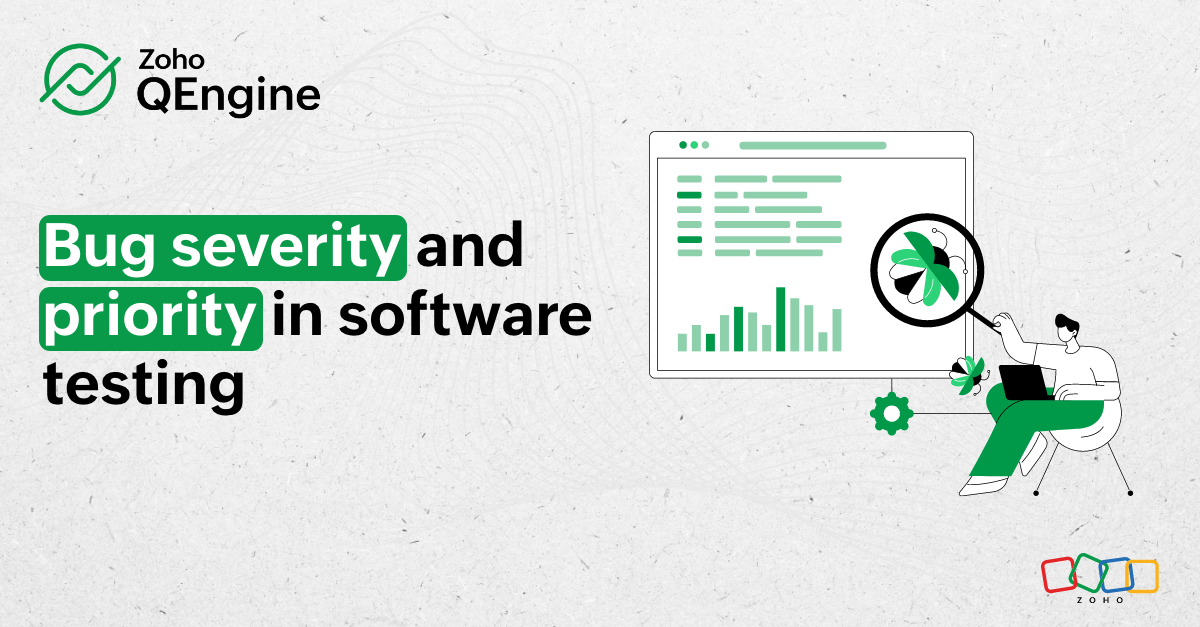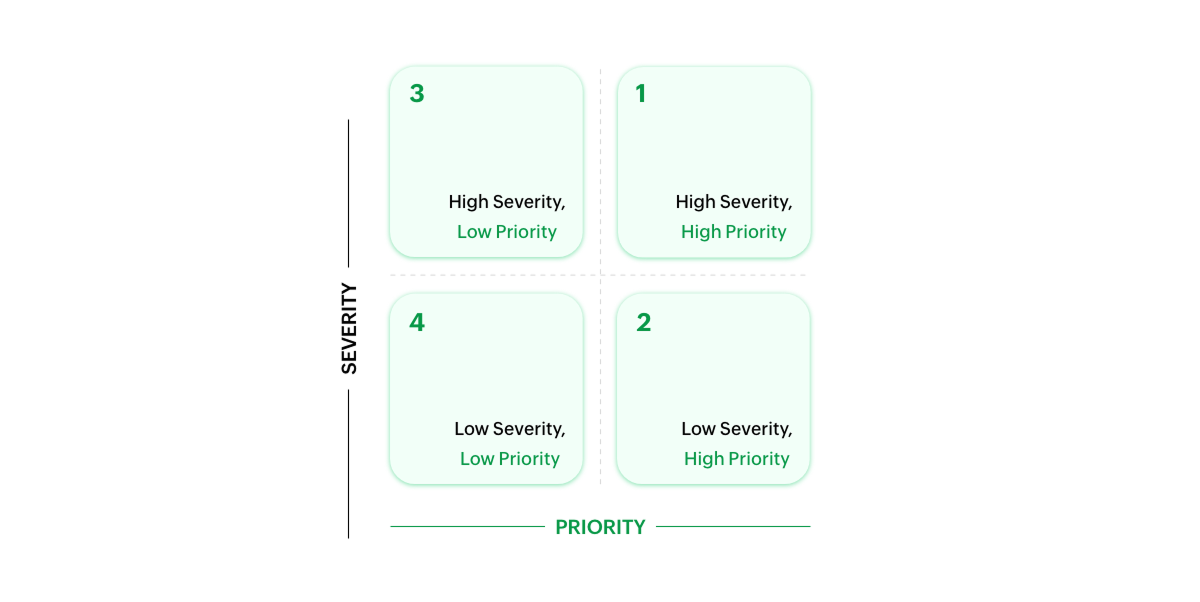Bug severity and priority in software testing
start testing free- Key takeaways
- Understanding bug severity and priority
- Bug tracking and reporting explained
- Determining the severity and priority of bugs
- Importance of the severity and priority levels of the bugs
- Analyzing the severity priority matrix
- Choosing the right tool for handling bugs
Key takeaways
Prioritizing bugs and defects based on their severity and impact on the business, and debugging them promptly, is crucial for ensuring the software's optimum performance.
- Severity vs priority: Bug severity is dependent on how the bug affects the software application's core functionality, and bug priority is determined by its impact on the business.
- Severity levels: There are four levels of bug severity (S1, S2, S3, and S4), ranging from S1 bugs, which are critical and affect core functionality, to S4 bugs, which are of low severity and don't have a huge impact.
- Priority levels: Bug priority is categorized into four levels (P1, P2, P3, and P4), ranging from bugs critical to the business to bugs that don't affect the business much at all.
- Bug tracking process: Bug tracking involves identifying bugs, categorizing them by severity and priority levels, providing detailed bug reports, and monitoring the status of various bugs.
- Severity-priority matrix: This helps determine which bugs are to be addressed first, depending on its severity and priority.
- Zoho QEngine benefits: Zoho QEngine's comprehensive test automation software ensures effective bug tracking and resolution with collaborative features, role-based access control, self-healing Al for broken locators, integration with project management tools, and insightful performance dashboards.

Bugs/errors/defects can greatly affect the performance of software, sometimes to an extent that it becomes unusable and even leads to losses for the business. Understanding the importance of classifying bugs and monitoring the different stages to resolution falls under bug tracking and reporting. After identifying the bugs, classifying them based on their severity and priority is essential for maximizing coverage.
Understanding bug severity and priority
Bug severity in software testing
Bug severity refers to the level of impact bugs or errors can have on the software itself. Based on their impact on essential features, bug severity is categorized as:
- S1 (Critical) - Any bug that affects core functionality of the software, rendering it unusable, is categorized as highly severe or critical.
- S2 (Severe) - Bugs that affect the performance of software functionalities to a great extent fall under the severe category.
- S3 (Normal) - These bugs don't require immediate attention, as they have minimal effect on the software's capabilities.
- S4 (Low) - Software behavior is largely unaffected by low-severity bugs.
Bug priority in software testing
Bug priority is responsible for the order in which bugs are addressed, and fall under one of four levels:
- P1 (Critical) - Bugs don't need to be the most severe to end up at the top of the priority list—they just need to have a huge impact on the business. These bugs are addressed right away, irrespective of their level of severity.
- P2 (High) - High prioritybugs affect the business, either directly or indirectly, to cause substantial damage, which is why they're addressed quickly.
- P3 (Medium) - These bugs can be ignored by the team in the moment, as they're not associated with major disruptions to the functioning of the software.
- P4 (Low) - Lowest on the priority list, these bugs are addressed only after higher priority ones are resolved.
Bug tracking and reporting explained
Identifying the severity and priority of bugs fall under the categorization phase of the bug tracking process. Bug tracking is the process of identifying and monitoring bugs in detail, to assess their impact and make necessary fixes. Bug tracking and reporting requires certain steps to be followed in a particular order:
- Identification - Identifying bugs is the foremost step of the bug tracking and reporting process. This is generally done by testers, but the bugs encountered by developers or end users while using the software are also added to the list.
- Categorization - Once the bugs are identified, the next step is to assess their severity and priority. This is a crucial step which involves not just the testers but also the QA managers and product owners.
- Reporting - A detailed bug report contains all the essential information about the bug, making it easier for the developers to start working on fixes. The report contains the bug ID, title, description, severity and priority levels, environments, steps to reproduce the bugs, and reference data (if any).
- Tracking - Bugs are resolved one after another, based on their severity and priority levels. Tracking the status of the bugs till they're resolved is the final step. A robust bug tracking system is usually in place to ensure that the bugs are tracked from start to finish.
Determining the severity and priority of bugs
When the severity and priority levels of a bug are finalized, it's easier for the development team to work on the fixes, as per the severity and priority matrix, which is discussed later in this article.
Generally, the severity of bugs is determined by testers, but in certain cases, when there is a disagreement between the QA and development team, the product owner steps in to finalize the severity. The priority of the bugs is usually determined by a manager, based on the product's roadmap and the impact on business.
Importance of the severity and priority levels of the bugs
Severity and priority levels help in deciding the order in which bugs are addressed, based on their impact. When the development team is working on the fixes for other bugs, there's a possibility that it can affect severity and priority levels. This change can sometimes greatly affect the placement of a bug inside the severity priority matrix, and subsequently the order in which the bugs are fixed. This is where bug tracking helps in efficient bug management.
Analyzing the severity priority matrix

The severity priority matrix is comprised of four different sections, to assess the order in which the bugs are to be addressed. The graph has severity on one axis and priority on the other. The four sections of the matrix, and the order of addressing the bugs, are as follows:
- Bugs that fall into the high severity, high priority section of the matrix are the ones that are addressed and resolved immediately. The bugs in this section are S3/S4 in severity and P3/P4 in priority levels, respectively—for example, a login or signup functionality error which disrupts the product workflow and affects user experience.
- The bugs in the low severity, high priority section are addressed next. These bugs correspond to S1/S2 in severity and P3/P4 in priority levels, respectively. They need to be addressed immediately, but the impact on the product's functionality is minimal—for example, a spelling mistake in the title of the home page or the product name itself. Even though it doesn't affect functionality, the brand image takes a hit.
- High severity, low priority section bugs are resolved after dealing with the bugs in the above two sections. The bugs in this section belong to S1/S2 and P3/P4 in the severity and priority levels, respectively—for example, a disclaimer or the privacy page not working is a serious issue, but doesn't need to be addressed immediately.
- The last and final set of bugs belong to the low severity, high priority section, which are resolved only if there are no other important issues at hand. These bugs are S3/S4 and P3/P4 in severity and priority respectively—for example, a spelling mistake or grammatical error for a success message doesn't require immediate action.
Choosing the right tool for handling bugs
Identifying bugs, tracking them from start to finish, and providing fixes based on their severity and priority levels is only possible with proper planning and the right tools. Zoho QEngine is test automation software that accurately uncovers bugs and aids in creating extensive bug reports. No-code and low-code test creation is supported on QEngine, along with a self-healing feature that helps rectify broken locators—and the insightful results dashboard provides deep analysis of all test executions.